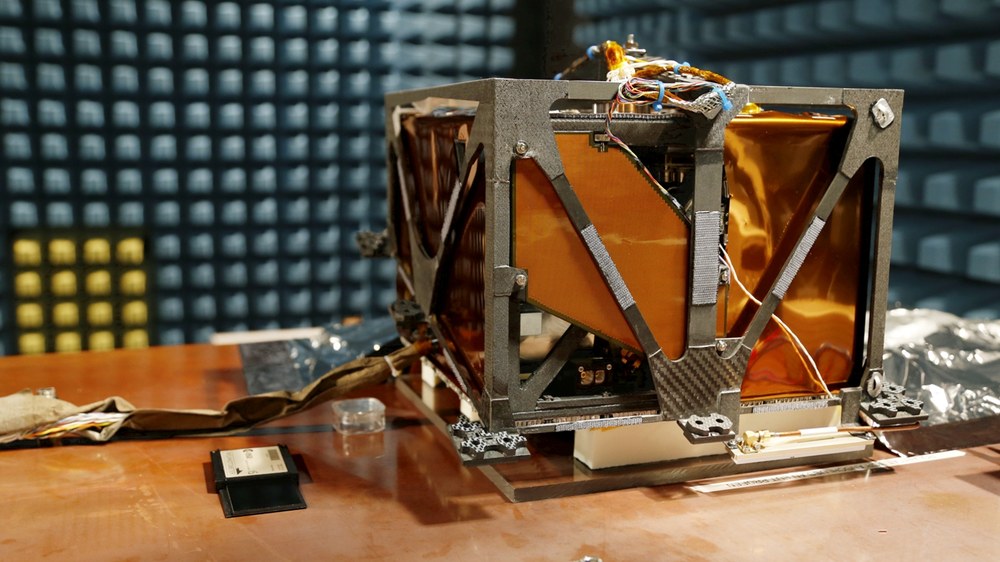EMC Laboratory



The EMC Laboratory (Electromagnetic Compatibility Laboratory) of the Institute of Space Systems investigates the electromagnetic compatibility of electronic or electrical systems and components for space applications to determine whether they function in a specific electromagnetic environment without generating unacceptable electromagnetic disturbances.
The flexible availability of the EMC Laboratory, as well as the close integration with other facilities of the institute, such as the mechanical-dynamic test laboratory, electronic laboratory and the integration laboratory, are particularly useful for the development of hardware within DLR, as integration, qualification and verification remain within the institute. A wide variety of test facilities are also available to accompany new developments over short distances.
Equipment
- Shielded 40 GHz semi-anechoic chamber with a usable area of 4.4 m x 5.2 m and a usable height of 2.7 m.
- Signal generators: DC to 40 GHz
- Measuring receivers: 20 Hz to 40 GHz
- Current clamps: 10 Hz to 1 GHz
- EMI antennas: 10 kHz to 18 GHz
- EMS antennas: 30 MHz to 6 GHz
- Magnetic field coils: 30 Hz to 100 kHz
- Broadband amplifier 125 W - 9 kHz to 250 MHz
- Broadband amplifier 70 W - 250 MHz to 1 GHz
- Broadband amplifier 20 W - 1 GHz to 18 GHz
- Transient generator max. 600V - 0.15/5/10ms
Our services at a glance
- Electromagnetic compatibility testing during development
- Performance of EMC tests and qualification of flight hardware
- Support in the development of EMC test procedures
- Fault analysis for electromagnetic incompatibilities
- Support in localizing and eliminating sources of interference
Accredited measurements and tests according to ECSS-E-ST-20-07C
- Conducted emission on power supply and signal lines, 30 Hz to 100 MHz (5.4.2/5.4.3)
- Radiated emission via electric field, 30 MHz to 40 GHz (5.4.6)
- Conducted susceptibility on power supply and signal lines, 30 Hz to 100 MHz (5.4.7/5.4.8)
- Radiated susceptibility via electric field, 30 MHz to 40 GHz (5.4.11)
Measurements Tests according to ECSS-E-ST-20-07C
- Measurement of the inrush current
- Conducted emission in the time domain
- Radiated emission via the magnetic field, 30 Hz to 100 kHz
- Conducted immunity to transient interference
- Radiated emission from magnetic fields, 30 Hz to 100 kHz
- ESD tests
Measurements and tests in accordance with MIL-STD-461F
- Conducted emission on power and signal lines, 30 Hz to 100 MHz
- Radiated emission via the electric field, 10 kHz to 40 GHz
- Radiated emission via the magnetic field, 30 Hz to 100 Hz
- Conducted susceptibility on power supply lines, 30 Hz to 100 kHz
- Conducted susceptibility on power supply and signal lines (BCI test), 100 kHz to 200 MHz
- Radiated susceptibility via electric fields in the frequency range, 30 MHz to 40 GHz
- Radiated susceptibility via magnetic fields, 30 Hz to 100 kHz
- ESD tests
Project Highlights
EU:CROPIS – Demonstration of the long-term stability of a biological life support system.
Implementation of the EMC verification tests of the individual sub-systems and payloads.
Wireless COMPOSE – Indoor positioning system in extreme environments for a demonstration on the ISS during the mission of Alexander Gerst.
Accompaniment of the project from the final development to the verification of the EMC suitability.
MaMMoTH-Up – System for researching and developing new avionics concepts in the launcher area.
Implementation of the qualification and verification of the EMC suitability of the system.
